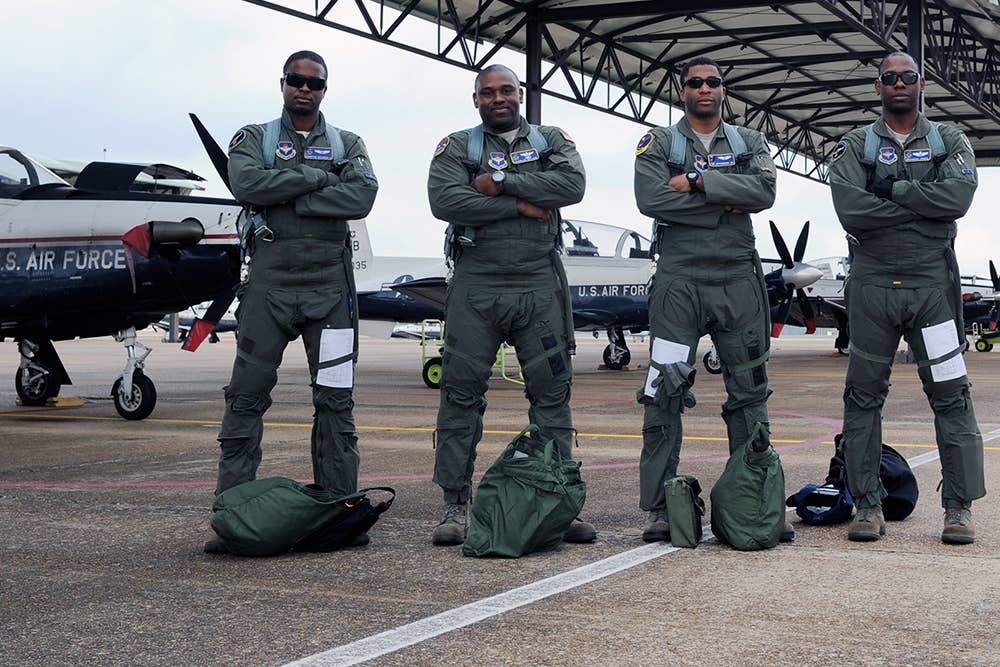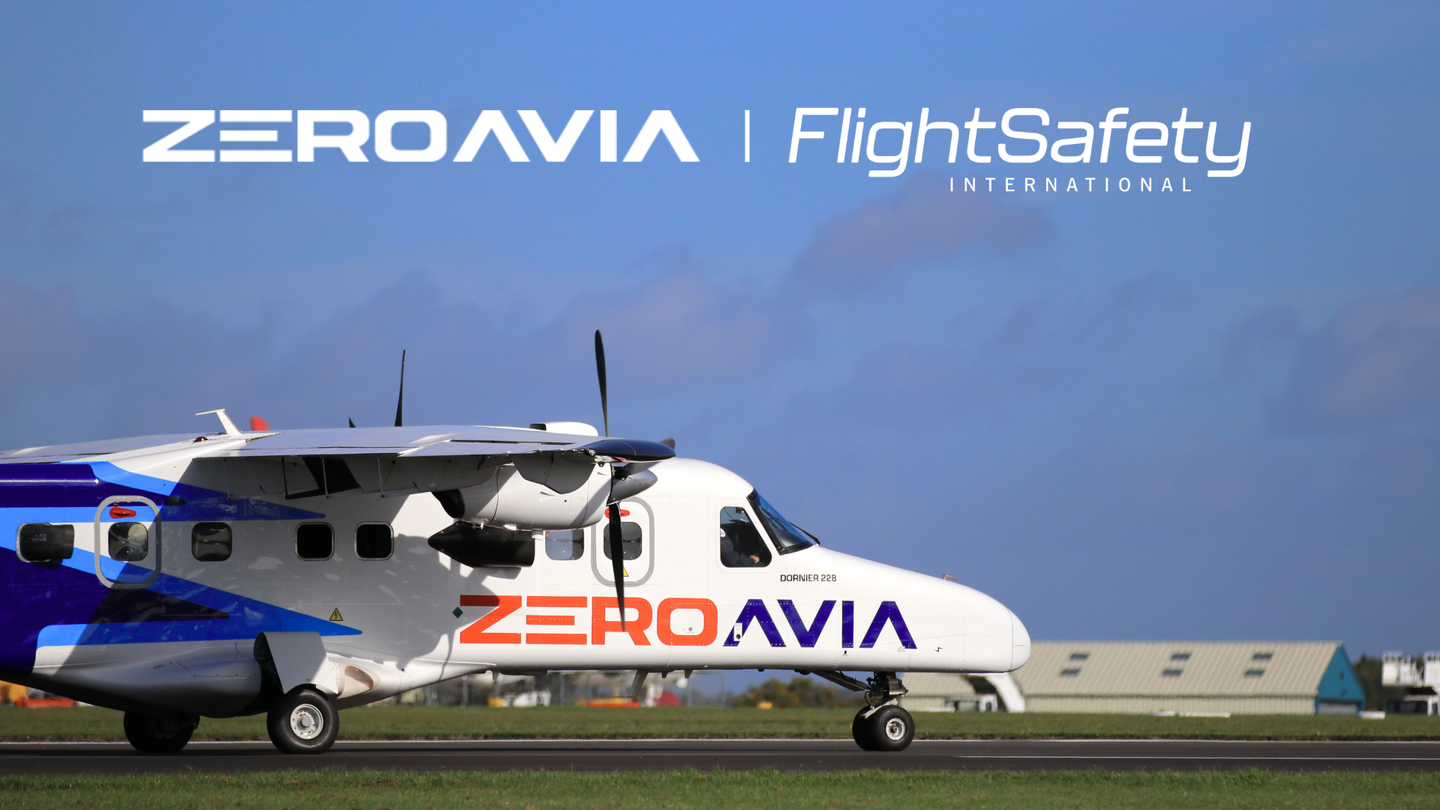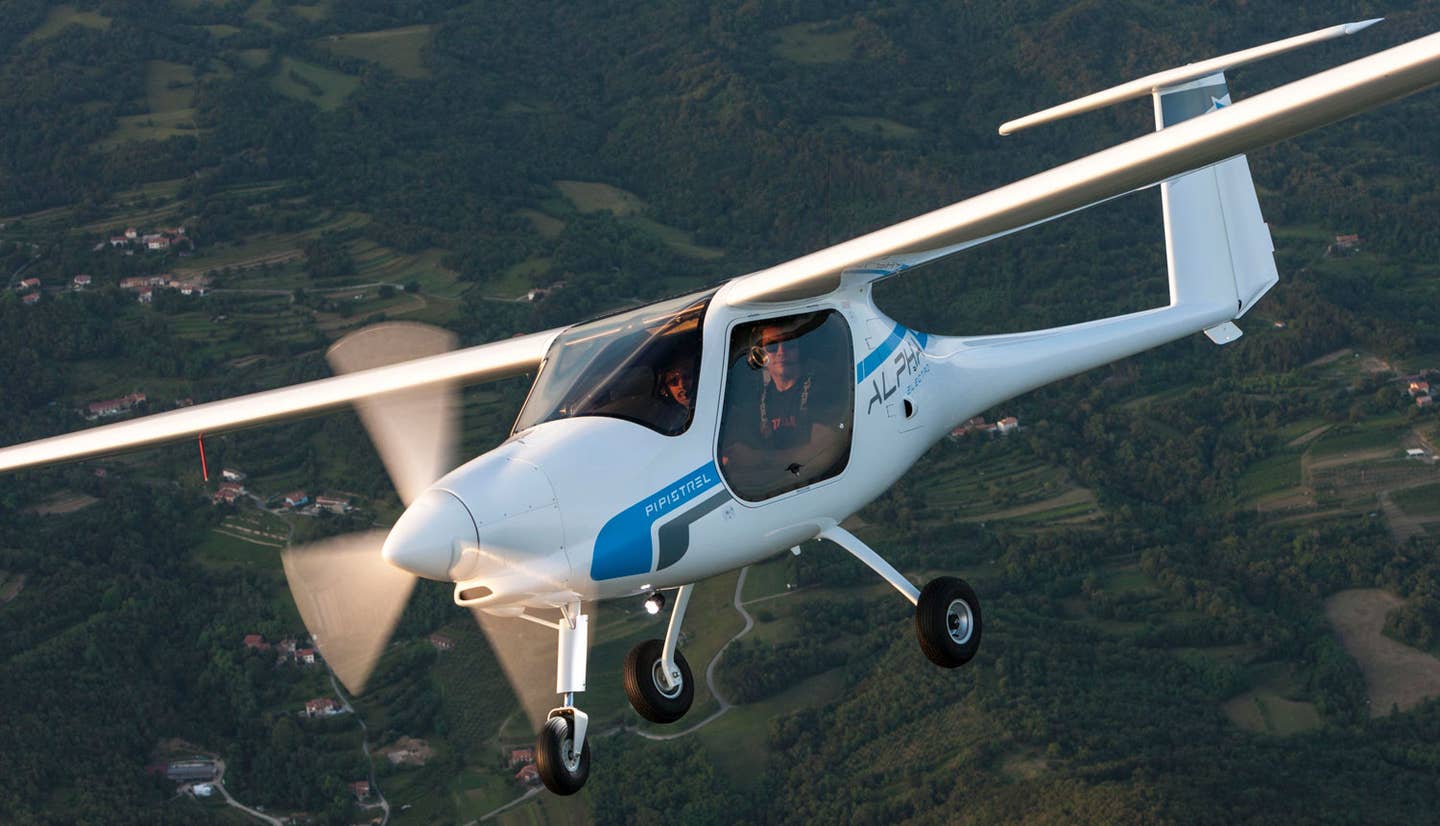Why Are There So Few African American Air Force Pilots?
The U.S. Air Force has fewer than 300 active-duty Black pilots, and one just quit. Here’s why.

Lt. Col. Charles Gilliam, 14th Student Squadron Director of Operations, poses for a photo with Capt. D. L. Booker, 14th Student Squadron Flight Commander, 1st Lt. Tim Jefferson Jr., 14th Operations Support Squadron Chief of Wing Airspace, and Maj. Brandon Jones, 14th Student Squadron Flight Commander, on Columbus Air Force Base, Mississippi, February 1. [Courtesy: Columbus Air Force Base]
Editor’s Note: This article is part of a month-long series celebrating Black History Month through aviation: Feb. 1: African American Pioneers in Flight and Space | Feb. 4: Legacy Flying Academy | Feb. 10: Why Aren’t There More Black Pilots in the Air Force? | Feb. 11: Jesse L. Brown | Feb. 15: Meet Four African Americans Making a Difference in Aviation | Feb. 18: From “Hidden Figures” to “Artemis” | Feb. 22: CMSAF Kaleth O. Wright | Feb. 25: Cal Poly Humboldt
By the time U.S. Air Force Major Daniel Walker climbed into the cockpit of a F-22 fighter jet for the first time, he was already taking off into the wind, buoyed by family legacy.
Walker's great uncle, Norman Wilfred Scales Sr., was a member of the Tuskegee Airmen, the famous World War II military aviators who opened doors for Black aviators in the U.S. Scales flew at least 70 missions in combat territory. He survived an airplane crash and achieved the rank of captain and earned the Distinguished Flying Cross—an incredible professional feat for a Black man from Texas in the 1940s.
Scales' story was a gift of both opportunity and obligation.
"My family is the reason I ended up in the Air Force," Walker told FLYING. "My dad's uncle was a Tuskegee Airmen and he flew P-51s in Germany. That's the legacy I grew up with, and grew up underneath. So, when you're a kid, you're searching for heroes, and one happened to be physically in your house by way of story…you kind of don't have a choice."
In 1941 and amid pressures of World War II, the U.S. military cracked open the door to Black pilots like Scales. During the war, Tuskegee Army Air Field turned out 650 single-engine pilots, 217 multiengine pilots, and 60 auxiliary pilots.
Seven decades later, underrepresentation is still an issue for Black pilots in the service. Of the U.S. Air Force's nearly 14,000 active-duty pilots, only 2 percent—fewer than 300—are Black, according to service data provided to FLYING.
By comparison, the Pew Research Center says that about 14 percent of the national population said they were Black in 2019.
"The question is, why are there so few African American pilots today? Certainly, there's no policy in place that prevents that, but there's just something where maybe it's a recruitment issue, maybe it's a retention issue, maybe it's the day-to-day life of these pilots," said historian Michael Hankins, curator of U.S. Air Force History at the Smithsonian National Air and Space Museum in Washington, D.C. "Are they experiencing racism throughout their careers in small ways that are so frustrating that it is hurting retention?"
In late 2020, the Department of the Air Force (DAF)-Inspector General released a Racial Disparity Review of military discipline procedures and career development opportunities based on a survey of 123,000 airmen and Space Force Guardians.
The IG found that enlisted Black Air Force service members were 72 percent more likely than their white counterparts to receive Uniform Code of Military Justice, Article 15, non-judicial punishment (NJP) as a form of discipline, which can include limited confinement, arrest in quarters, extra duties, or forfeiture of pay for incidents of minor misconduct. Black service members were 57 percent more likely than white service members to face courts-martial.
Other findings in the IG report included that:
- Young Black enlisted service members were nearly twice as likely to be involuntarily discharged for misconduct compared to white enlisted service members.
- Black Air Force service members were 1.64 times more likely to be suspects in Office of Special Investigations criminal cases.
- Black Air Force service members were overrepresented in support career fields while underrepresented in operational career fields, which could impact promotion opportunities.
- Of the more than 123,000 surveyed, about 60 percent of Black service members believed they do not and would not receive the same benefit of the doubt as white peers.
- And, about 40 percent of Black enlisted, civilians, and officers do not trust their chain of command to address issues related to racism, bias, and disparate career opportunities.
The IG's findings, however, indicated that there was no consistent disparity among races when it came to retention rates, a conclusion underscored by recent service data. According to Air Force data provided to FLYING, the retention rate for Black active-duty officers in 2021 was 93.78 percent, and in line with the retention rate of white officers (93.73 percent), Hispanic officers (94.51 percent), and those identified as "other" (93.97 percent).
According to a snapshot of Air Force demographics in September 2021, 15 percent of service personnel self-reported as Black or African American.
And much like the service's history in decades past, that ratio fell significantly in the officer corps.
"Black officers represent 6 percent of the DAF Active Duty population," the IG said.
In rated operations in the Air Force, Black officers were underrepresented in the more elite officer positions, IG found. Rated officers include pilots, combat systems officers, air battle managers, remote-piloted-aircraft pilots, and flight surgeons.
When it comes to the service's bread-and-butter mission, Black representation continues to remain nearly invisible. In 2021, the Air Force accounted for 13,789 active-duty officers with a pilot aeronautical rating, according to service data. Of those officers, only 283—about 2 percent—were Black pilots.
Bucking the System
Walker was among that 2 percent. Yet, three generations after his great uncle put on a flight suit, the F-22 pilot —a man who graduated in the top 10 percent of his undergraduate pilot training class, holds multiple degrees, has accrued more than 1,000 hours of flight time, and who was an instructor pilot—confronted a similar element of the Tuskegee Airmen's experience: racial bias.
One of Walker's first experiences with bias was a little over a decade ago, during the time sandwiched between graduation from the U.S. Air Force Academy and pilot training, when he worked as a recruiter for the Academy. He requested to go to Southern California in order to find diverse candidates. The white air liaison officer organizing the trip sent Walker to Beverly Hills, an area known for its wealth and majority white population.
"This is America, so race plays a measurable role in, like, everything," Walker said, recalling the incident that he says showed bias in a "more benign but material way."
"I kind of laughed and I kind of realized that without people like me or other minorities of different sorts in the mix, this is what the Air Force thought was diversity because to this air liaison officer (ALO), that's what he thought it was," Walker said. "Race as a factor, I'm sure, played into it, but not in a cross-burning type of way.”
In flight school, he received feedback that he talked too much. Then, when he joined an F-22 fighter squadron in Virginia, he was criticized for being too quiet and conveying that "he thinks he's too good to be here or too good for this place," he told 60 Minutes last year. He was also told that his manner of walking was intimidating.
"We need to take ownership. We need to own this situation. We need to have those tough dialogues."
Lieutenant General Brad Webb, commander of the Air Force Air Education and Training Command (AETC), during an on-camera discussion about race and diversity with U.S. Air Force Major Daniel Walker in July 2020.
The message was abundantly clear: conform or your fighter pilot career will suffer.
"Before I got to the Air Force—before I even got to the Academy—these sort of racially charged traumatic experiences traveled down generations," Walker said. "Your parents tell you how it was for them. Older pilots tell you how it was for them. And, you know, I could go back at least one generation of Air Force aviators, their story is exactly the same as mine. Some are more overt or more egregious than mine in some ways, and others not, but the stories are essentially the same," he said.
After 11 years as one of the few Black pilots in the Air Force, it was enough to prompt Walker to leave the service. He separated from the Air Force January 1, 2022.
"To have these stories reach back 30, 40, 50 years, all the way to very similar stories in my own experience, gives you the sense that Big Air Force may never care and that's something you've just got to live with if you want to live out your dream," Walker said.
One Step Forward, One Step Back
On July 26, 1948, President Harry Truman signed an executive order committing to equal treatment without regard to race, color, religion, or national origin in all U.S. military services. By May 1949, the U.S. Air Force had begun desegregating.
While the system had changed quickly, the culture had not.
"With Truman's help, the Air Force desgregated rapidly and smoothly but then it neglected to monitor the continuing problems of Negro airmen," said U.S. Air Force historian Lieutenant Colonel Alan Gropman wrote in a post-World War II study, "The Air Force Integrates: 1945-1964." Among the many issues that emerged in a newly integrated service was that Black airmen promotions to supervisory positions stagnated between 1949 and 1962.
Compared to the other U.S. military services, the Air Force was faster to integrate, Hankins said. "They were ready to do it. There was still some resistance to it, certainly, within the service, but the Air Force was much quicker and more complete about their integration effort" than the Navy or the Army, he said.
The gains from being first, however, were then followed by a period of inaction. A cycle began to emerge, Hankins said.
"The military, and in particular, the Air Force will take some major reform action, and then it will be a very good moment where things kind of move forward," Hankins said. "Then the military leadership kind of considers the problem solved. And then, things have improved, but nothing is completely solved, and so other problems continue to fester."
By the 1970s, the racial divide fractured further along other lines. More than two decades after the Air Force integrated, Black airmen found fewer promotion opportunities.
In June 1972, for example, there were only 2,124 Black officers in the Air Force, accounting for 1.7 percent of the service's total officer corps of 118,671 personnel, according to service data.
"There was an increasing representation of African Americans throughout the military so the overall percentages were starting to get more in line with the general population," Hankins said. "The officer corps had a much lower percentage, a much less representative percentage of African Americans," he said.
"The higher in rank you go, the less representative it was," Hankins said.
‘I Am George Floyd’
In late May 2020, video of George Floyd struggling to breathe as he was killed by a Minneapolis police officer sparked global protest, as well as a personal response from the Air Force's top enlisted officer, Chief Master Sergeant of the Air Force Kaleth O. Wright.
"I am George Floyd…I am Philando Castile, I am Michael Brown, I am Alton Sterling, I am Tamir Rice," Wright wrote in a public commentary.
"I hope you realize that racism/discrimination/exclusion does not care much about position, titles or stature," he said. "As I struggle with the Air Force’s own demons that include the racial disparities in military justice and discipline among our youngest Black male Airmen and the clear lack of diversity in our senior officer ranks…I can only look in the mirror for the solution."
Who am I?
— JoAnne S. Bass (@cmsaf_official) June 1, 2020
I am a Black man who happens to be the Chief Master Sergeant of the Air Force.
I am George Floyd…I am Philando Castile, I am Michael Brown, I am Alton Sterling, I am Tamir Rice.
(1) pic.twitter.com/KuVpPkAjcm
Wright pledged a full review of the Air Force's military justice system, as well as to work to improve diversity, particularly in higher ranks. "[W]hile we have made progress in many of the areas that impact our Airmen and families; I believe that we have not made much progress in this area of racial injustice and diversity among our ranks," he said.
For Walker, the words coming from the highest non-commissioned officer in the service meant that difficult social issues centered around race were no longer off limits.
"George Floyd was not the first Black man to be killed in a very public way, or even be assaulted in a very public way," Walker said. "This is the first time, however, where this is sanctioned Air Force communication from Air Force leadership addressing the issue. …there is now a shift in where, and who could have these conversations, which meant Black people could have those conversations in service as servicemen, not only after they took the uniform off."
Addressing Complicated Issues
In the wake of the IG review, the Air Force says progress is being made.
“These disparities and gaps in trust affect our operational readiness—we don’t have time or talent to lose,” Under Secretary of the Air Force Gina Ortiz Jones said in September.
According to the Air Force, some examples of actions addressing racial disparity include:
- Increasing ROTC scholarships at minority-serving institutions.
- Initiating a new "GO Inspire" program in January designed to increase Air and Space Force general officer outreach to youth, to increase diversity in operational career fields and the broader force.
- Drafting the DAF Diversity, Equity, Inclusion and Accessibility Strategy
- Requiring an action plan on all Defense Equal Opportunity Climate Survey climate factors relating to Diversity, Inclusion, or Equal Opportunity that score an “improvement needed”
- Establishing Diversity, Equity, and Inclusion offices with chief diversity inclusion officers across major commands.
- Initiating the Command Justice Climate Tool to track adverse administrative actions with regard to age, rank, gender, and race of those issuing and receiving counseling, admonishments, and reprimands.
- Revising policy for diverse slates for key military positions.
- Updating command authority to inspect and remove flags affecting good order and discipline.
"While assessing the root causes of racial, ethnic, and gender disparities within the DAF is important, what is more critical are the actions required to address the disparities that exist, and ensuring equity and inclusion for all Airmen and Guardians," Air Force spokesperson Laurel Tingley told FLYING in a statement. "Since the initial release [of the IG report], stakeholders have been conducting root-cause analysis of complicated issues and, where appropriate and warranted, devising systemic, and lasting actions intended to directly address specific disparities," she said.
"The ultimate measure of success is meaningful, positive trends in operational outcomes, retention and Airman/Guardian success stories, which take time and planning to achieve," Tingley added. "Department leaders have already started implementing corrective measures to address some of the concerns expressed by our service members, including increased training on unconscious bias and inclusive leadership, with leadership accountability measures in the works."
The service is also looking to the Air Force Academy as an inroad to improving diversity. As part of aviation recruitment efforts targeting underrepresented communities, the Academy is working with Air Force Recruiting Command Detachment 1's Aviation Inspiration Mentorship (AIM) High Flight Academy, an aviation-based motivation and mentorship program.
Students at the Academy's prep school, the intense 10-month program located on campus that is focused on preparing cadet candidates through academics, athletics, and military training, are also eligible for aviation exposure programs, such as powered flight fundamentals.
"Prep school students account for 16 percent of the Cadet Wing, but are 28 percent of the racial/ethnic minorities," Tingley said. "We have these initiatives at the prep school because early exposure to aviation is critical for driving interest."
At the Academy, aviation exposure continues for freshmen with a 10-lesson virtual reality T-53 simulator. "The goal is to ensure 100 percent of cadets experience AV-100 in their first two years at the Academy," Tingley said. "We use the end of course critique data, plus the initial exposure to aviation, to help vector them towards additional USAFA airmanship programs."
The Air Force is also attempting to improve diversity by looking within and has launched the Rated Preparatory Program as a pathway to flight training for active-duty airmen with little exposure to flying to help them compete on Undergraduate Flying Training (UFT) boards.
“RPP candidates are active-duty airmen who traditionally have little to no flight experience, which translates to less than five hours of civilian flight time,” said Brigadier General Brenda Cartier, Air Education and Training Command (AETC) director of operations and communication.
The weight of prior flying experience required at UFT boards is a barrier, Cartier said. "Prior flying experience particularly poses a socioeconomic barrier to candidates who possibly did not have access or the financial means to pay for flying lessons prior to entering the Air Force. RPP effectively addresses this barrier by providing qualified Airmen hands-on instruction and flight time at no personal cost."
‘We Will Be Judged’
The way forward requires listening and taking substantive action, Air Force leaders acknowledge.
"We need to take advantage of this kind of moment in time to bring about fundamental change," said Lieutenant General Brad Webb, commander of the Air Force Air Education and Training Command (AETC), during an on-camera discussion about race and diversity with Walker in July 2020. "We need to take ownership. We need to own this situation. We need to have those tough dialogues," he said.
"This is the start of something different, and when you ask about optimism, it's certainly in the room."
U.S. Air Force Major Daniel Walker
"In our Air Force, we generally tend to not talk about race. We don't talk about religion. We don't talk about politics. We probably don't talk about gender," Webb said. "All of these things at this point are dialogues that need to occur if we're to actually have substantive breakthrough of barriers."
"This is our moment," he added. "We will be judged by what we either do or don't do."
During the hour-long conversation, Walker told the commander anecdotes that exemplified the many times he's had to navigate bias and racism in and out of uniform.
When asked if he was encouraged by the actions being taken, Walker read comments from other Black fighter pilots: "My fighter experience was the most demoralizing experience in my life and I've been homeless," one said.
"To be yourself and thrive in a fighter squadron as a Black man is an oxymoron. Either conform or fail," wrote another.
"This is the start of something different, and when you ask about optimism, it's certainly in the room," Walker said. "We're holding out for, is this going to keep up?"
Now, however, Walker will watch the Air Force's next steps tackling race as a civilian. His decision to leave the service in January was prompted by an acceptance letter to Harvard Law School, an opportunity he couldn't pass up, he told FLYING. A law degree "is an extremely powerful tool to have in my possession to champion rights, either at a civic level or individual level," he said.
"The reason I spoke up was because it is that common. And it's a shared experience that almost all of my black compatriots went through," Walker said. "So, the news is not that it happened to me, the news is that it happened to most of them."

Sign-up for newsletters & special offers!
Get the latest FLYING stories & special offers delivered directly to your inbox






